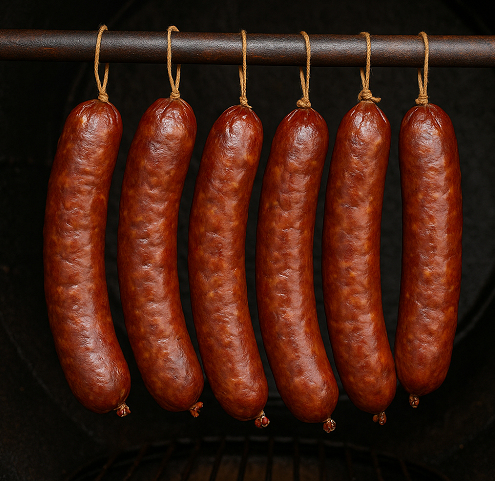Andouille Sausage: A Definitive Guide for Hunters, Smokers & Gourmets


Why Andouille Matters in the World of Smoked Meats
Andouille sausage is not just another cured meat—it’s a linchpin of Cajun and Creole cuisine, a showcase for smoke technique, spice mastery, and meatcraft. Whether you’re making gumbo, jambalaya, sausage boards, or simply smoking links for the freezer, mastering andouille elevates your craft.
Origins & Evolution: From French “Andouillette” to Cajun Powerhouse
French Roots: Andouille and Andouillette
- The name “andouille” comes from French charcuterie traditions, originally referring to sausages made from pig intestines, chitterlings, onions, and seasoning, often boiled or poached.
- In France, andouillette is a smaller, often intensely flavored sausage made from coarsely cut intestines. It’s leaner, with a strong aroma — an “acquired taste.”
- Regional French varieties such as andouille de Guémené or d’Aire-sur-la-Lys have distinct approaches to smoking, slicing, and ingredients.
The Louisiana Transformation: Cajun & Creole Andouille
- French colonial settlers and Acadian exiles brought sausage-making skills to Louisiana. Over time, the sausage evolved to reflect local ingredients, heat tolerance, and smoke techniques.
- Whereas the French original often included internal organs, Louisiana-style andouille is typically pork shoulder, fat, spices, and heavy smoking.
- The city of LaPlace, Louisiana, openly markets itself as the “Andouille Capital of the World.”
Takeaway: The modern andouille we most often use in the U.S. is a refined balance — meat-forward, coarse in texture, richly smoked, spiced rather than organ-heavy.
Flavor & Texture Profile: What Makes Excellent Andouille
What distinguishes an exceptional andouille link? Let’s analyze:
Key Taste Components
| Component | Role / Effect |
|---|---|
| Smokiness | The backbone — good andouille will announce itself as “smoked meat,” not just “sausage.” Woods like pecan, hickory, or oak impart distinct sweetness and depth. |
| Savory / Umami / Pork Character | It must still taste like pork — not just smoke. The balance of lean and fat ensures meat flavor shines through. |
| Spice / Heat | Black pepper, cayenne, and perhaps paprika or chili flakes give a lingering warmth, often described as moderate—enough to tease but not scorch. |
| Garlic / Onion / Herbs | These provide aromatic and flavor layering. Garlic is almost always present; onion, thyme, or oregano may appear depending on recipe versions. |
| Salt / Cure | Salt must be balanced — enough for preservation, flavor, and bringing out other notes, but not so much as to dominate. |
Texture & Mouthfeel
- Coarse grind / chunkiness: Traditional andouille is not a fine emulsified sausage; it often contains visible chunks of meat and fat.
- Firm, dense bite: It should hold together under heat without disintegrating, yet not be gummy.
- Crisp casing when seared or grilled: The natural casing crisps and gives a pleasant “snap” when bitten.
- Fat rendering and juiciness: When cooked properly, rendered fat mingles with smoke and spice to give a moist interior.
Aromatic and Aftertaste Notes
- Nutty / sweet smoke notes (especially pecan or hickory)
- Residual warmth — the spice lingers, not as a one-punch burn
- Garlic/pepper echoes on the finish
- Deep porky richness under the smoke
If your andouille tastes only like “burnt wood” or only “hot pepper,” you’re missing balance.
Recipe: How to Make Classic Pork Andouille Sausage (Cajun Style)
Here is a tested, full-protocol version with tips from a seasoned butcher/smoker. It improves on many home recipes by optimizing cure, smoke scheduling, and textural control.
Ingredients (for roughly 10–12 lb batch)
| Ingredient | Weight / Volume | Purpose / Notes |
|---|---|---|
| Pork shoulder (50–60% lean/fat) | ~4.5 kg (10 lb) | The meat base — good balance of lean+fat |
| Pork back fat (if needed) | ~1.5 kg (3.3 lb) | To ensure fat ratio ~25–30% total |
| Kosher salt | 1.8% of meat weight (≈110 g for 6 kg) | For seasoning & preservation |
| Prague Powder #1 (Cure #1) | 150–200 ppm (≈1.0–1.2 g per kg) | For color, flavor, and safety |
| Black pepper (cracked) | 5 g per kg meat | For bite and backbone |
| Garlic (fresh or pressed) | 3–5 g per kg | Depth and aroma |
| Cayenne pepper | Start at 2 g/kg, adjust to taste | Heat layer |
| Paprika (smoked or sweet) | Optional, ~3 g/kg | Adds color and mild flavor |
| Thyme, oregano, bay leaf (crushed) | Small amounts, optional | Subtle herbal layer |
| Cold water or ice | 5–8% of meat weight | Helps with mixing, protein extraction |
| Casings | Beef bung or thick hog casing | Strong enough to handle repeated smoking |
Fat ratio target: 25–30% fat (by weight). Too lean, and the sausage will be dry; too fatty, and it will break or tallow out.
Equipment & Setup
- Meat grinder (1/2″ and 3/16″ plates)
- Sausage stuffer
- Smoker or offset barrel / pellet / electric smoker
- Thermometer probes (ambient & internal)
- Bowls, mixing tubs, clean surfaces
- Hooks or racks for hanging
- Vacuum sealer or butcher paper
Process Steps
Step 1: Meat Preparation & Trim
- Trim the pork shoulder into 1–2″ cubes. Keep fat and lean separate if you need to adjust fat percentages.
- Chill meat and fat to near-freezing (0–4 °C) to prevent smearing.
Step 2: Grind & Mix
- Pass the lean through a coarse plate (½″) for chunkiness.
- Pass fat through 3/16″ or a fine plate.
- Combine lean, fat, seasonings, and cold water in a mixing tub.
- Mix for 3–4 minutes to extract myosin and ensure seasoning distribution, but don’t overheat (target <10 °C).
Step 3: Cure / Rest (Optional but recommended)
- Refrigerate the seasoned meat for 12–24 hours. This helps bind, equalize moisture, and deepen flavor.
- Stir periodically to reposition meat and check for color and consistency.
Step 4: Stuff and Link
- Soak casings in warm water, rinse.
- Stuff to medium firmness (avoid overstuffing).
- Tie into 8–12″ links, or any preferred length. Use twine or hog ring clips.
- Prick any large air pockets gently with a sterile pin.
Step 5: Drying Phase (Pre-Smoke)
- Hang or lay on racks in a cool (~15–20 °C), well-ventilated area for 2–4 hours to “skin up” — this helps smoke adhere.
Step 6: Smoking Phase (Cold / Warm Smoke)
- Begin smoke at ~110–120 °F (43–49 °C) for 1 hour (no smoke) to firm up.
- Ramp to ~140–145 °F (60–63 °C) as smoke begins (light smoke).
- Over 4–6 hours, gradually increase smoke intensity (more dense smoke or wood) but keep ambient ≤ 140–150 °F.
- Total smoke duration: 6–8 hours or until the casing develops a mahogany color.
Step 7: Finish Cooking to Safe Internal Temp
- Increase smoker temp to 170–185 °F (77–85 °C) to drive internal temps up gradually.
- Cook until each link reaches internal 154–158 °F (68–70 °C). Avoid overshooting.
- Use a pan of hot water or steam inside smoker to maintain humidity and prevent drying.
- Alternatively, you can poach or steam in 170–175 °F water for ~20 min to finish.
Step 8: Chill, Rest & Cure (optional)
- Rapid-chill by placing links on cold surface or in an ice bath; then refrigerate.
- Let rest for 24 hours (vacuum-sealed or wrapped) — flavors deepen and slices bind better.
Step 9: Storage
- Refrigerate (wrapped) up to 7 days.
- Freeze (vacuum-sealed) up to 3–4 months for optimal quality.
Troubleshooting Tips
- Sausage splits: casing too tight or heating too fast.
- Pale color: insufficient smoke — extend smoke time or increase density earlier.
- Gummy interior: not enough cure, undercooked, or too much fine meat — increase coarse chunks.
- Too spicy: reduce cayenne for next batch, or mix with milder sausage.
- Dry links: lower finish temp ramp or increase fat ratio slightly.
Variations & Substitutes
Chicken / Poultry Andouille
- Use boneless chicken thighs (dark meat) plus skin for fat.
- Maintain a fat ratio ~20–25%.
- Adjust seasoning slightly (less metallic or liver undertones).
- Smoke profile remains similar.
- Taste is lighter but retains andouille character. (The “Taste of Artisan” site includes a chicken andouille variation.)
Game Andouille: Venison, Wild Boar, Duck
- Use a lean game meat blend (e.g., venison) + pork fat to punctuate flavor.
- Game meats usually require more careful temperature control to avoid dryness.
- Increase resting time and ensure even fat distribution.
Lighter / Low-Fat Versions
- Reduce fat by substituting leaner pork cuts + plant-based fat (e.g. lard, tallow)
- Use “liquid smoke” cautiously with mild smoke sessions.
- Be cautious — too lean and the sausage will be dry or brittle.
Vegetarian / Vegan Andouille Analogues
- Use textured vegetable protein (TVP), smoked tofu, or seitan as base.
- Incorporate smoked paprika, liquid smoke, smoked salt, and garlic/cayenne for flavor.
- Bind with vital wheat gluten or plant-based binders.
- Not true andouille, but useful for dietary restrictions.
Cooking & Serving Strategies: Getting the Most Out of Andouille
Cooking Methods
| Method | How / Tips | Benefits |
|---|---|---|
| Grill / Char / Sear | Direct high heat, rotate, crisp casing | Char flavor, texture contrast |
| Simmer / Poach | In broth or stock (160–175 °F) | Gentle heating for gumbo/jambalaya base |
| Pan-fry / Skillet | Slice and brown with fat | Crisp edges & rendered fat |
| Smoke again / Re-heat | Low temp hold or finishing smoke | Re-activate smoke flavor for serving |
| Bake / Roast | In oven (350 °F) for 15–20 min | Hands-off method; use water pan to retain moisture |
Classic Pairings & Dishes
- Gumbo: Andouille is foundational—slice or chunk it into the roux/broth.
- Jambalaya / Red Rice: Works with chicken, shrimp, or alone.
- Red Beans & Rice: As a flavor vehicle.
- Po’boys & sandwiches: With slaw, hot sauce, crisp bread.
- Sausage boards / charcuterie: Pair with mustard, pickles, cheese, crusty bread.
- Grilled vegetable or sausage skewers: Cube and alternate with peppers/onion.
- Soup / bean-pot accompaniments: Adds depth and interest to basic broths.
Balancing & Serving Tips
- Acid and brightness (e.g. chopped parsley, lemon squeeze, hot sauce) help cut through fat and smoke.
- Serve slightly warm or room temp — the fat softens flavor release.
- For sliced presentations, score casing lightly to aid cutting.
- Use the drippings rendered during cooking—save the fat for frying veggies or creating roux base.
Storing, Safety & Shelf Life
- Pre-cooked andouille is shelf stable when vacuum-sealed and refrigerated; once opened, use within 7 days.
- Freeze in airtight packaging (remove as much air as possible) for up to 3–4 months without significant quality drop.
- When thawing, do so in the refrigerator overnight, not at room temperature.
- To repasteurize, heat gently to 140 °F internal before slicing, to avoid texture damage.
Comparison: Andouille vs Other Sausages
- Kielbasa / Polish sausage: Generally milder, often garlicky, not heavily smoked, finer texture.
- Chorizo: Spicier, often uses paprika or chilis, sometimes raw-cured, typically fully emulsified.
- Hot links / Nelson links: More heat, often leaner, may lack deep smoke character.
- Bratwurst / Weisswurst: Mild, subtle, often not smoked.
Unique differentiation: Andouille’s hallmark is the marriage of smoke + spice + coarse texture + pork character.



